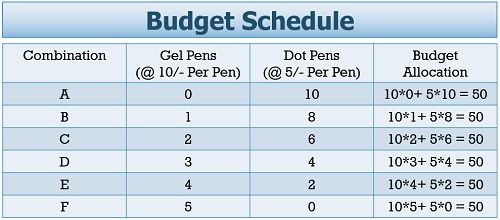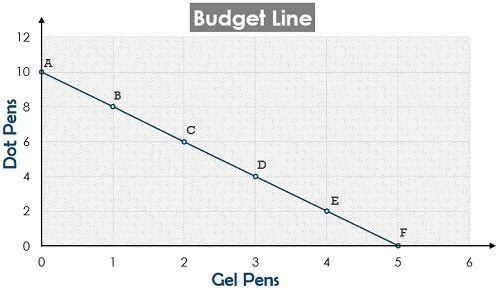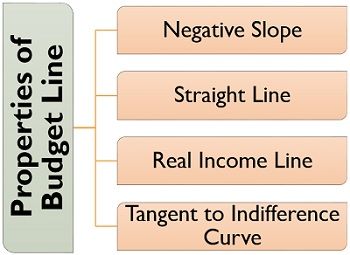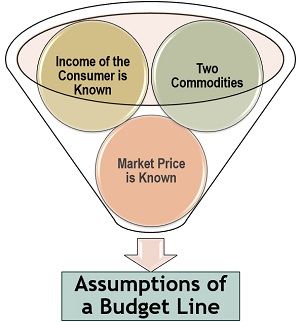Definition: A budget line is a straight line that slopes downwards and consists of all the possible combinations of the two goods which a consumer can buy at a given market price by allocating all his/her income. It is an entirely different concept from that of an indifference curve, though they are both are essential for consumer equilibrium.
The two essential components of a budget line are:
- The purchasing power of a consumer, i.e. his/her income;
- The market price of both commodities.
Content: Budget Line
Equation of Budget Line
The concept of the budget line is precisely explained through the following equation:
![]() Where,
Where,
Px is the price of goods X;
Qx is the quantity of goods X;
Py is the price of goods Y;
Qy is the quantity of goods Y;
M is the income of the consumer.
Example: A person has 50/- for buying pens. He/She has the following options for allocating his/her amount such that he/she derives the maximum utility from limited income:
 The above Budget schedule can be plotted on a graph to obtain the appropriate budget line for this instance;
The above Budget schedule can be plotted on a graph to obtain the appropriate budget line for this instance;
 Budget Set: Budget set defines all such combinations of the two goods lying within the affordability limit of a consumer.
Budget Set: Budget set defines all such combinations of the two goods lying within the affordability limit of a consumer.
Market Rate of Exchange (MRE)
The market rate of exchange refers to the ratio of units sacrificed of Y to acquire specific units of X at a given market price. It indicates the slope of a budget line.
Price Ratio
The price ratio can be understood as the relationship between the prices of the two goods say X and Y, where both the products are inversely related to each other. It is constant throughout a budget line.
Equation:
![]() Where,
Where,
Px is the price of Goods X; and
Py is the price of Goods Y.
Properties of Budget Line
It has specific characteristics which distinguish it from other economic tools.
Some of these features are discussed below:
- Negative Slope: It slopes downward showing an inverse relationship between the buying of the two goods.
- Straight Line: It is a straight line which denotes the constant market rate of exchange at each combination.
- Real Income Line: It functions on the principle of income and the spending capacity of a consumer.
- Tangent to Indifference Curve: The indifference curve touches the budget line at a point, and this point is known as the consumer’s equilibrium.
Assumptions of a Budget Line
As we know that economics is mostly based on assumptions, so goes for the budget line.
To make the results and analysis more clear and easy to understand, the economist assumes the following in respect of a budget line:
- Two Commodities: It is believed that the consumer will spend all his/her income on purchasing only two goods.
- Income of the Consumer is Known: The consumer’s income is limited and is known, even the revenue is wholly allocated for buying only two commodities.
- Market Price is Known: The market price of both the goods are known to the consumer.
- Expenditure is equal to the Income: We assume that the consumer spends all his/her income.
Slope of Budget Line
The slope of a budget line can be determined with the help of Market Rate of Exchange.
Why does a budget line slope downward?
As we know that the consumer has a fixed income, he/she has to let go of some quantity of Goods Y to get an additional unit of Goods X.
This inverse relationship between both commodities leads to a declining slope.
Please refer the above-given example to get a practical overview of a downward sloping budget line.
Shift in Budget Line
A budget line consists of consumer’s income, the price of the goods and the quantity in which they are purchased. Here, the volume of products is a controllable agent while the other two may vary with time.
Therefore, it shifts from its original position due to the following two primary reasons:
Shift due to Change in Price: The price of a commodity is volatile in nature and change from time to time. The market price of the goods will either decrease or increase.
If the other factors like income and price of goods Y remain constant and the price of one commodity say X decreases; the buying capacity of the consumer for goods X will automatically increase.
If the other factors remain constant, and the price of goods X increases, the buying capacity of the consumer for goods X will automatically decrease.
Shift due to Change in Income: Income is another vital agent that leads to a shift in the budget line.
An increase in the consumer’s income means expansion of his/her purchasing power and vice-versa, thus leading to a shift in budget line too.
Conclusion
A budget line is that part of the budget set, which highlights all possible combinations of two commodities and focuses on the expenditure of total income.
It works on the principle of sacrificing one commodity to acquire more of the other goods within a limited income and at a specified market price.
Ashiimu owomugisha says
Thanks for the fed back hope to help me again
M Abdullah says
it’s very helpful to clear all of confusion about budget line.Wonderful just amazing!!!
Adeola says
Thank you so much this really help me
It
Brenda Weloba says
Very good answers.
Linus says
This is self explanatory. GREAT CONTENT
Nozipho says
Great lesson it really helped me to prepare a lesson for my learners
reyhan says
Thanks for the very interesting info
Annikie Moloi says
good read